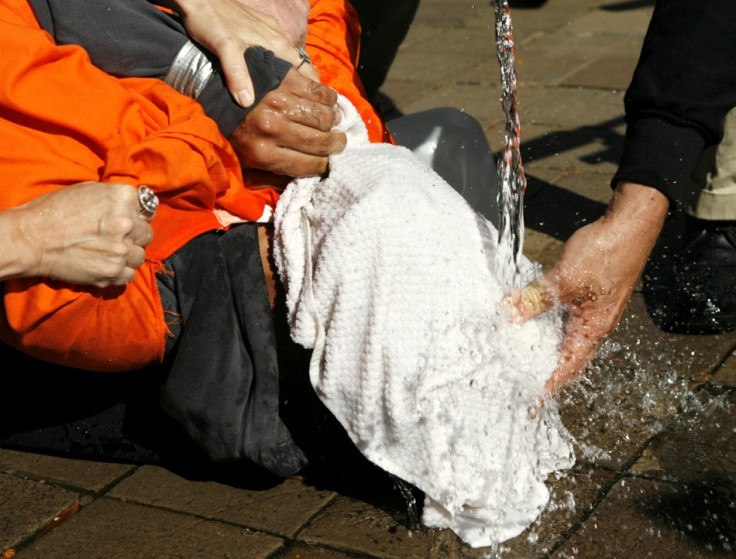What is waterboarding, the 'enhanced' interrogation technique Trump wants to bring back?
The effect of the flowing water simulates the effect of drowning so that the subject feels like they will die.
US President Donald Trump has said repeatedly he believes strongly that "enhanced interrogation techniques" will provide intelligence services an edge when protecting America from its enemies.
While his opponents and human rights groups have called the techniques illegal torture, Tump has said he believes the US intelligence services need to "fight fire with fire".
"When they're chopping off the heads of our people, and other people. When they're chopping off the heads of people because they happen to be a Christian in the Middle East – when Isis is doing things that nobody has ever heard of since medieval times, would I feel strongly about waterboarding? As far as I'm concerned, we have to fight fire with fire," the president said in an interview with ABC.
Trump faces opposition in his move to bring back waterboarding. If Trump were to reinstate the technique, he would be violating a 2015 US law and go against the view of his Defence Secretary James Mattis.
CIA director, Mike Pompeo, told senators earlier in January that he would not sanction the use of torture, but later said he would consider reinstating waterboarding under certain circumstances.
However, the president said he has also spoken to "people at the highest level of intelligence" who told him that waterboarding and torture "absolutely" works. So how does waterboarding work?
In most waterboarding techniques a prisoner is tied to a board with their head raised slightly above their feet. A material such as cloth or cellophane is wrapped over the prisoner's face and water is poured over the material.

The effect of the flowing water simulates the effect of drowning so that in essence the subject feels like they will die. As the gag reflex sets in, coupled with the need to inhale and exhale the prisoner is confronted with the immediate fear of death and will instinctively yield.
ABC reports that CIA officers who employed the waterboarding technique after it was sanctioned for use during the 2003 invasion of Iraq said prisoners lasted on average 14 seconds before they gave up.
Because of the efficacy of the waterboarding technique in making prisoners fear they are going to die, CIA operatives have questioned its usefulness in extracting confessions.
It is "bad interrogation. I mean you can get anyone to confess to anything if the torture's bad enough," CIA officer Bob Baer was quoted as saying.
John Sifton from Human Rights Watch said in 2007 while the technique was being used that it was essentially a violation of international law. "The person believes they are being killed, and as such, it really amounts to a mock execution, which is illegal under international law," he said.
In 2008, at the time there was a debate in the US as to whether waterboarding should really be considered torture, the late journalist Christopher Hitchens was himself waterboarded as an experiment. He wrote an eloquent piece for Vanity Fair titled: Believe Me, It's Torture.
"You may have read by now the official lie about this treatment, which is that it "simulates" the feeling of drowning. This is not the case. You feel that you are drowning because you are drowning — or, rather, being drowned, albeit slowly and under controlled conditions and at the mercy (or otherwise) of those who are applying the pressure. The "board" is the instrument, not the method. You are not being boarded. You are being watered. This was very rapidly brought home to me when, on top of the hood, which still admitted a few flashes of random and worrying strobe light to my vision, three layers of enveloping towel were added. In this pregnant darkness, head downward, I waited for a while until I abruptly felt a slow cascade of water going up my nose...I held my breath for a while and then had to exhale and—as you might expect—inhale in turn. The inhalation brought the damp cloths tight against my nostrils, as if a huge, wet paw had been suddenly and annihilatingly clamped over my face. Unable to determine whether I was breathing in or out, and flooded more with sheer panic than with mere water, I triggered the pre-arranged signal and felt the unbelievable relief of being pulled upright and having the soaking and stifling layers pulled off me. I find I don't want to tell you how little time I lasted."
Hitchens concluded:
"I apply the Abraham Lincoln test for moral casuistry: 'If slavery is not wrong, nothing is wrong' Well, then, if waterboarding does not constitute torture, then there is no such thing as torture."
Source: Vanity Fair
© Copyright IBTimes 2025. All rights reserved.






















